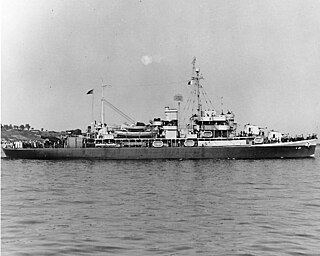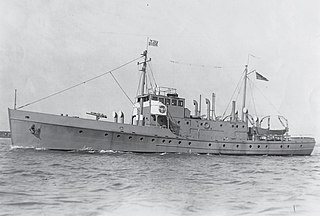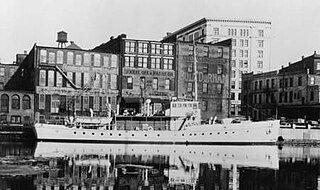
Harriet Rebecca Lane Johnston acted as first lady of the United States during the administration of her uncle, lifelong bachelor President James Buchanan, from 1857 to 1861. She has been described as the first of the modern First Ladies, being a notably charming and diplomatic hostess, whose dress-styles were copied, and who promoted deserving causes. In her will, she left funds for a new school on the grounds of Washington National Cathedral. Several ships have been named in her honor, including the cutter USCGC Harriet Lane, still in service, as of 2021.

USCGC Tamaroa (WAT/WMEC-166), originally the United States Navy Cherokee-class fleet tugUSS Zuni (ATF-95), was a United States Coast Guard cutter. Following the U.S. Coast Guard custom of naming cutters in this class of ship after Native American tribes, she was named after the Tamaroa tribe of the Illiniwek tribal group.

USCGC Acushnet (WMEC-167) was a cutter of the United States Coast Guard, homeported in Ketchikan, Alaska. She was originally USS Shackle (ARS-9), a Diver-class rescue and salvage ship commissioned by the United States Navy for service in World War II. She was responsible for coming to the aid of stricken vessels and received three battle stars during World War II, before a long career with the Coast Guard. Acushnet patrolled the waters of the North Pacific and was one of the last World War II era ships on active duty in the US fleet upon her retirement in 2011.

Harriet Lane was a revenue cutter of the United States Revenue Cutter Service and, on the outbreak of the American Civil War, a ship of the United States Navy and later Confederate States Navy. The craft was named after the niece of senator and later United States President, James Buchanan; during his presidency, she acted as First Lady. The cutter was christened and entered the water for the Revenue Service in 1859 out of New York City, and saw action during the Civil War at Fort Sumter, New Orleans, Galveston, Texas, and Virginia Point. The Confederates captured her in 1863, whereupon she was converted to mercantile service. Union forces recaptured her at the end of war. The U.S. Navy declared her unfit for service and sold her. New owners out of Philadelphia renamed her Elliot Ritchie. Her crew abandoned her at sea in 1881.
USCGC Spar (WLB-403) was a 180-foot (55 m) sea going buoy tender. An Iris class vessel, she was built by Marine Ironworks and Shipbuilding Corporation in Duluth, Minnesota. Spar's preliminary design was completed by the United States Lighthouse Service and the final design was produced by Marine Iron and Shipbuilding. On 13 September 1943 the keel was laid, she was launched on 2 November 1943 and commissioned on 12 June 1944. The original cost for the hull and machinery was $865,941.

The Wind-class icebreakers were a line of diesel electric-powered icebreakers in service with the United States Navy, United States Coast Guard, Royal Canadian Navy, Canadian Coast Guard and Soviet Navy from 1944 through the late 1970s. They were very effective ships: all except Eastwind served at least thirty years, and Northwind served in the USCG continuously for forty-four years. Considered the most technologically advanced icebreakers in the world when first built, the Wind-class icebreakers were also heavily armed; the first operator of the class was the United States Coast Guard, which used the vessels for much-needed coastal patrol off Greenland during World War II. Three of the vessels of the class, Westwind, Southwind, and the first Northwind all went on to serve temporarily for the Soviet Union under the Lend-Lease program, while two others were built for the United States Navy and another was built for the Royal Canadian Navy; all eight vessels were eventually transferred to the United States Coast Guard and the Canadian Coast Guard.

USCGC Harriet Lane (WMEC-903) is a United States Coast Guard medium endurance cutter. Named after Harriet Lane, niece and official hostess of President James Buchanan. Harriet Lane was constructed by Tacoma Boatbuilding, Tacoma, Washington and delivered 20 April 1984.

USCGC Tampa (WMEC-902) is a United States Coast Guard medium endurance cutter. She was commissioned 16 March 1984. Her motto, "Thy way is the sea, thy path in the great waters", matches the inscription that is engraved on the memorial at Arlington National Cemetery for the 131 persons lost following the sinking of a previous cutter Tampa on September 18, 1918.

USS Biscayne (AVP-11), later AGC-18, was a United States Navy Barnegat-class seaplane tender in commission as a seaplane tender from 1941 to 1943 and as an amphibious force flagship from 1943 to 1946. She saw service during World War II. Transferred to the United States Coast Guard after the war, she was in commission as the Coast Guard cutter USCGC Dexter (WAGC-385), later WAVP-385 and WHEC-385, from 1946 to 1952 and from 1958 to 1968.

USS Unimak (AVP-31) was a United States Navy Barnegat-class small seaplane tender in commission from 1943 to 1946 that saw service in World War II. After the war, she was in commission in the United States Coast Guard as the cutter USCGC Unimak (WAVP-379), later WHEC-379, WTR-379, and again WHEC-379, from 1949 to 1975 and from 1977 to 1988.

USCGC Cuyahoga (WIX-157) was an Active-class patrol boat built in 1927 which saw action in World War II. Cuyahoga sank after a night-time collision in the Chesapeake Bay while on patrol in 1978. She was later raised and re-sunk as an artificial reef off the Virginia coast and is a popular recreational dive site.
USCGC Harriet Lane refers to three ships of the United States Coast Guard:

USS Humboldt (AVP-21) was a United States Navy Barnegat-class small seaplane tender in commission from 1941 to 1947 that served in the Atlantic during World War II. She was briefly reclassified as a miscellaneous auxiliary and redesignated AG-121 during 1945. After the war, she was in commission in the United States Coast Guard as the cutter USCGC Humboldt (WAVP-372), later WHEC-372, from 1949 to 1969,

USCGC Stratton (WMSL-752) is the third Legend-class cutter of the United States Coast Guard. It is the first "white hull" cutter named after a woman since the 1980s. Stratton is named for Coast Guard Captain Dorothy C. Stratton (1899–2006). Stratton served as director of the SPARS, the Coast Guard Women's Reserve during World War II.
USCGC Point Banks (WPB-82327) was an 82-foot (25 m) Point-class cutter constructed at the Coast Guard Yard at Curtis Bay, Maryland in 1961 for use as a law enforcement and search and rescue patrol boat by the United States Coast Guard. Since the Coast Guard policy in 1961 was not to name cutters under 100 feet (30 m) in length it was designated as WPB-82327 when commissioned and acquired the name Point Banks in January 1964 when the Coast Guard started naming all cutters longer than 65-foot (20 m).

USCGC Cahoone (WPC/WSC/WMEC-131) was an Active-class patrol boat of the United States Coast Guard. Launched in 1927, she served until 1968.

The Active-class patrol boat was one of the most useful and long-lasting classes of United States Coast Guard cutters. Of the 35 built in the 1920s, 16 were still in service during the 1960s. The last to be decommissioned from active service was the Morris in 1970; the last in actual service was the Cuyahoga, which sank after an accidental collision in 1978.

USCGC McLane (WSC-146) was a 125 ft (38 m) United States Coast Guard Active-class patrol boat in commission from 1927 to 1971. She was named for Louis McLane, (1786–1857) who was appointed in 1833 as United States Secretary of State. In May 1966, she was redesignated as (WMEC-146).

USCGC Jackson was an Active-class cutter of the United States Coast Guard. She capsized in 1944, killing twenty one of forty crew members.

USCGC Antietam (WSC-128), later Bedloe was an Active-class cutter of the United States Coast Guard where she was commissioned from 1927 to 1944. She sank in 1944, killing 26 crewmembers.
















